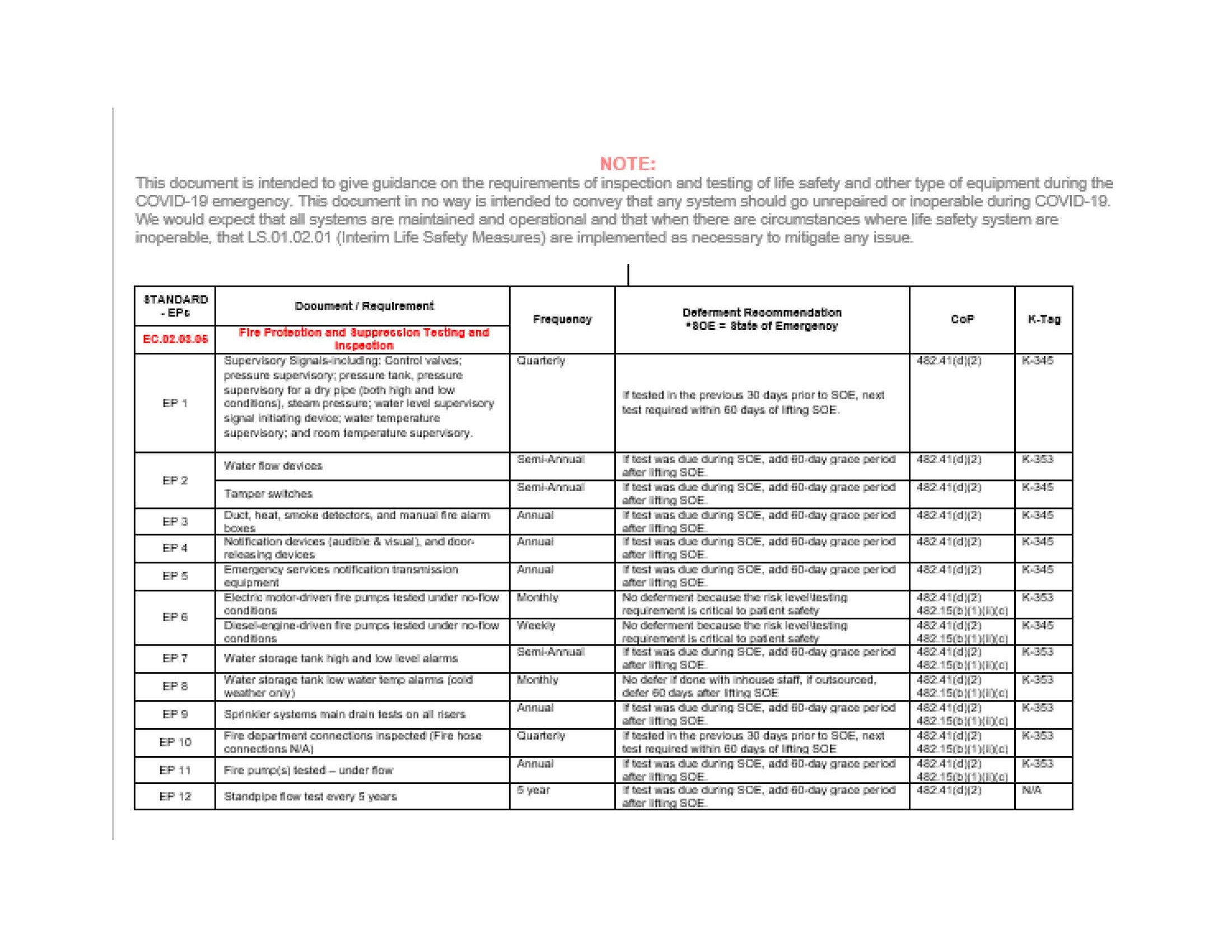Inspection, Testing, and Maintenance of Health Care Facilities during COVID-19

As COVID-19 continues to change our way of life, the way Inspection, testing, and maintenance (ITM) of fire protection systems is also changing, specifically in health care facilities. The virus has overwhelmed many hospitals across the country raising the question of how to complete normal facility maintenance including ITM for fire protection for these facilities. Until recently there were no approved guidelines on how to address this issue from Centers for Medicare and Medicaid services (CMS). On April 29, 2020 CMS released COVID-19 Emergency Declaration Blanket Waivers. These waivers are designed to reduce disruption of patient care and exposure of coronavirus. Page 23 of these waivers address the modification of certain ITM requirements in health care facilities.
Items not included in the CMS waiver:
- Sprinkler system monthly electric motor-driven and weekly diesel engine-driven fire pump testing
- Portable fire extinguisher monthly inspection
- Elevators with fire fighters’ emergency operations monthly testing
- Emergency generator 30 continuous minute monthly testing and associated transfer switch monthly testing
- Means of egress daily inspection in areas that have undergone construction, repair, alterations or additions to ensure its ability to be used instantly in case of emergency
It should be noted that this waiver does not override state and local requirements which facilities are required to comply with. CMS adopts the 2012 Life Safety Code which specifies the 2011 edition NFPA 25, The standard for Inspection, Testing, and Maintenance of Water-Based Fire Protection Systems. This edition of NFPA 25 does not define frequency requirements. Most states have adopted more recent editions of the life safety code which will adopt later editions of NFPA 25. The later editions of NFPA 25 have defined frequencies. The waiver will provide frequency guidelines on when and what ITM is to be conducted. Provided the pandemic ends soon, the waiver frequencies will fall within the frequency requirements defined in NFPA 25 (2014 – 2020). This should allow these facilities to meet most state and local requirements however, it is always a good idea to consult the local Authority Having Jurisdiction to verify any requirements.
As an example, using the CMS table requirements below compared to NFPA frequency requirements, inspection of the fire department connection (FDC) is required quarterly by both CMS and NFPA 25. If an FDC was inspected April 15, 2020 then in accordance with the CMS it would have to be inspected again 60 days after lifting the state of emergency (SOE). If the SOE was lifted June 1, 2020 the inspection of the FDC would have to be completed by August 1, 2020. In accordance with NFPA 25 the FDC would have to be inspected again by August 31, of 2020.
| EP 10 | Fire department connections inspected (Fire hose connections N/A) | Quarterly | If tested in the previous 30 days prior to SOE, next test required within 60 days of lifting SOE | 482.41(d)(2) 482.15(b)(1)(ii)(c) | K-353 |
NFPA 25, 2020
3.7 Inspection, Testing, and Maintenance (ITM) Task Frequencies.
3.7.1* Frequency. Minimum and maximum time between events.
3.7.1.1 Daily Frequency. Occurring every day.
3.7.1.2 Weekly Frequency. Occurring once per calendar week.
3.7.1.3 Monthly Frequency. Occurring once per calendar month.
3.7.1.4 Quarterly Frequency. Occurring four times per year with a minimum of 2 months and a maximum of 4 months.
3.7.1.5 Semiannual Frequency. Occurring twice per year with a minimum of 4 months and a maximum of 8 months.
3.7.1.6 Annual Frequency. Occurring once per year with a minimum of 9 months and a maximum of 15 months.
3.7.1.7 Three Years Frequency. Occurring once every 36 months with a minimum of 30 months and a maximum of 40 months.
3.7.1.8 Five Years Frequency. Occurring once every 60 months with a minimum of 54 months and a maximum of 66 months.
Even though these waivers allow for modified ITM it is a good idea for facilities to establish fundamental ITM actions, such as ensuring that control valves for automatic sprinkler systems are in the open position, fire pumps are on and readily available, fire alarm control units/panels are clear of trouble, supervisory, and alarm signals, emergency power systems are readily available, and elements such as egress paths are as free and clear as possible.
Complete 1135 Emergency Declaration Blanket waiver can be found here: Waiver
Templates for submitting ITM waivers to CMS can be found here: Waiver

